Organisational Behaviour: Analysing BBC's Culture, Motivation, Teams
VerifiedAdded on 2020/07/22
|11
|4085
|27
Report
AI Summary
This report provides an in-depth analysis of organisational behaviour, focusing on the British Broadcasting Corporation (BBC) as a case study. It begins by examining Handy's culture typology, exploring power, role, task, and person cultures within the context of the BBC. The report then delves into the impact of organisational culture, politics, and power on individual behaviour and team performance. Furthermore, it explores process and content theories of motivation, including Maslow's Hierarchy of Needs and Herzberg's Motivation-Hygiene Theory, and discusses practical motivational tools to enhance work efficiency. The report also covers different types of teams in the workplace, including problem-solving, virtual, cross-functional, and project teams, and describes the Tuckman model of team development. Finally, it examines strategies to enhance team performance and productivity, while also addressing potential barriers to effective performance within an organisation like the BBC. The report aims to provide a comprehensive understanding of organisational behaviour principles and their application in a real-world setting.

ORGANISATIONAL
BEHAVIOUR
BEHAVIOUR
Paraphrase This Document
Need a fresh take? Get an instant paraphrase of this document with our AI Paraphraser
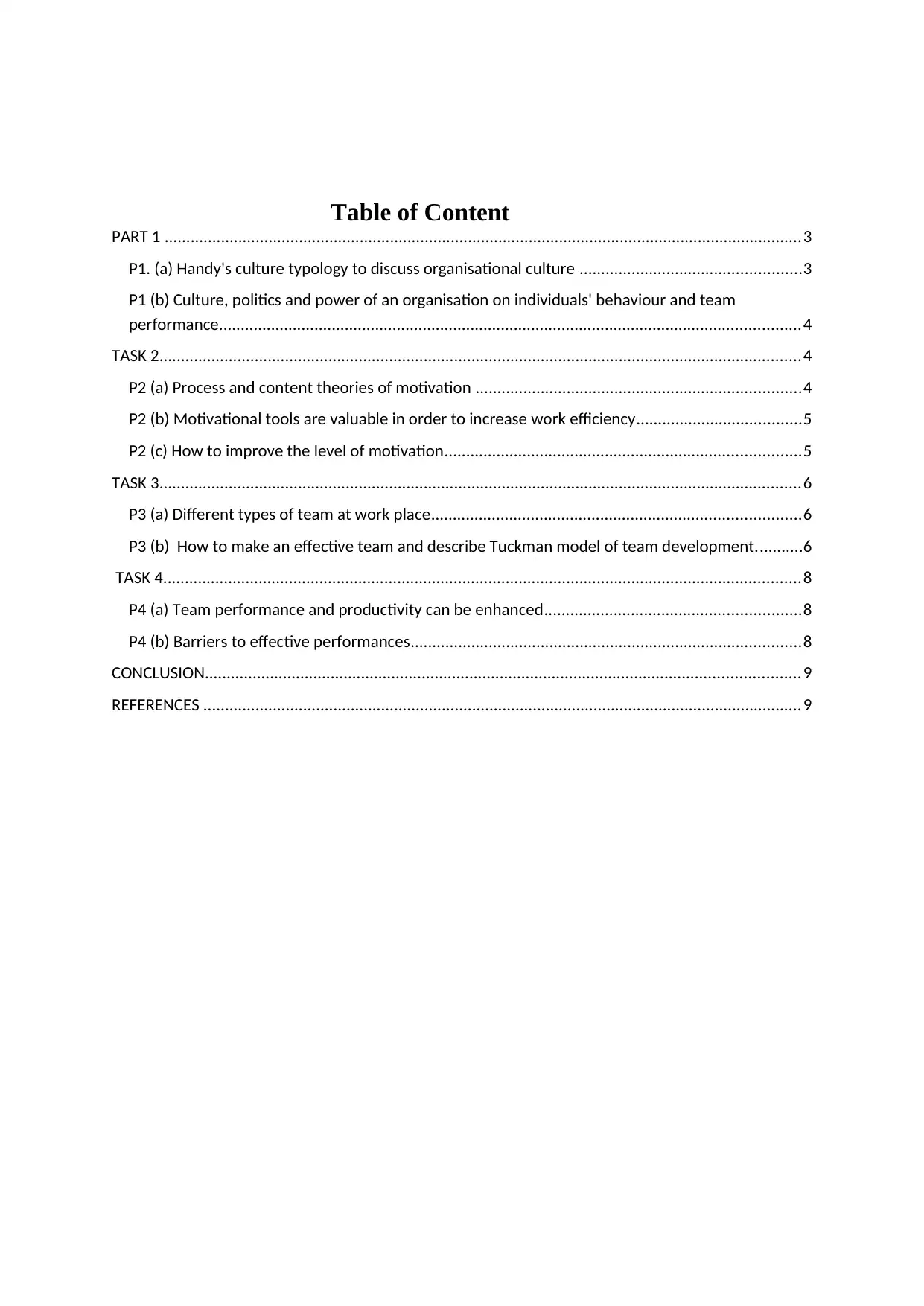
Table of Content
PART 1 ...................................................................................................................................................3
P1. (a) Handy's culture typology to discuss organisational culture ...................................................3
P1 (b) Culture, politics and power of an organisation on individuals' behaviour and team
performance......................................................................................................................................4
TASK 2....................................................................................................................................................4
P2 (a) Process and content theories of motivation ...........................................................................4
P2 (b) Motivational tools are valuable in order to increase work efficiency......................................5
P2 (c) How to improve the level of motivation..................................................................................5
TASK 3....................................................................................................................................................6
P3 (a) Different types of team at work place.....................................................................................6
P3 (b) How to make an effective team and describe Tuckman model of team development...........6
TASK 4...................................................................................................................................................8
P4 (a) Team performance and productivity can be enhanced...........................................................8
P4 (b) Barriers to effective performances..........................................................................................8
CONCLUSION.........................................................................................................................................9
REFERENCES ..........................................................................................................................................9
PART 1 ...................................................................................................................................................3
P1. (a) Handy's culture typology to discuss organisational culture ...................................................3
P1 (b) Culture, politics and power of an organisation on individuals' behaviour and team
performance......................................................................................................................................4
TASK 2....................................................................................................................................................4
P2 (a) Process and content theories of motivation ...........................................................................4
P2 (b) Motivational tools are valuable in order to increase work efficiency......................................5
P2 (c) How to improve the level of motivation..................................................................................5
TASK 3....................................................................................................................................................6
P3 (a) Different types of team at work place.....................................................................................6
P3 (b) How to make an effective team and describe Tuckman model of team development...........6
TASK 4...................................................................................................................................................8
P4 (a) Team performance and productivity can be enhanced...........................................................8
P4 (b) Barriers to effective performances..........................................................................................8
CONCLUSION.........................................................................................................................................9
REFERENCES ..........................................................................................................................................9
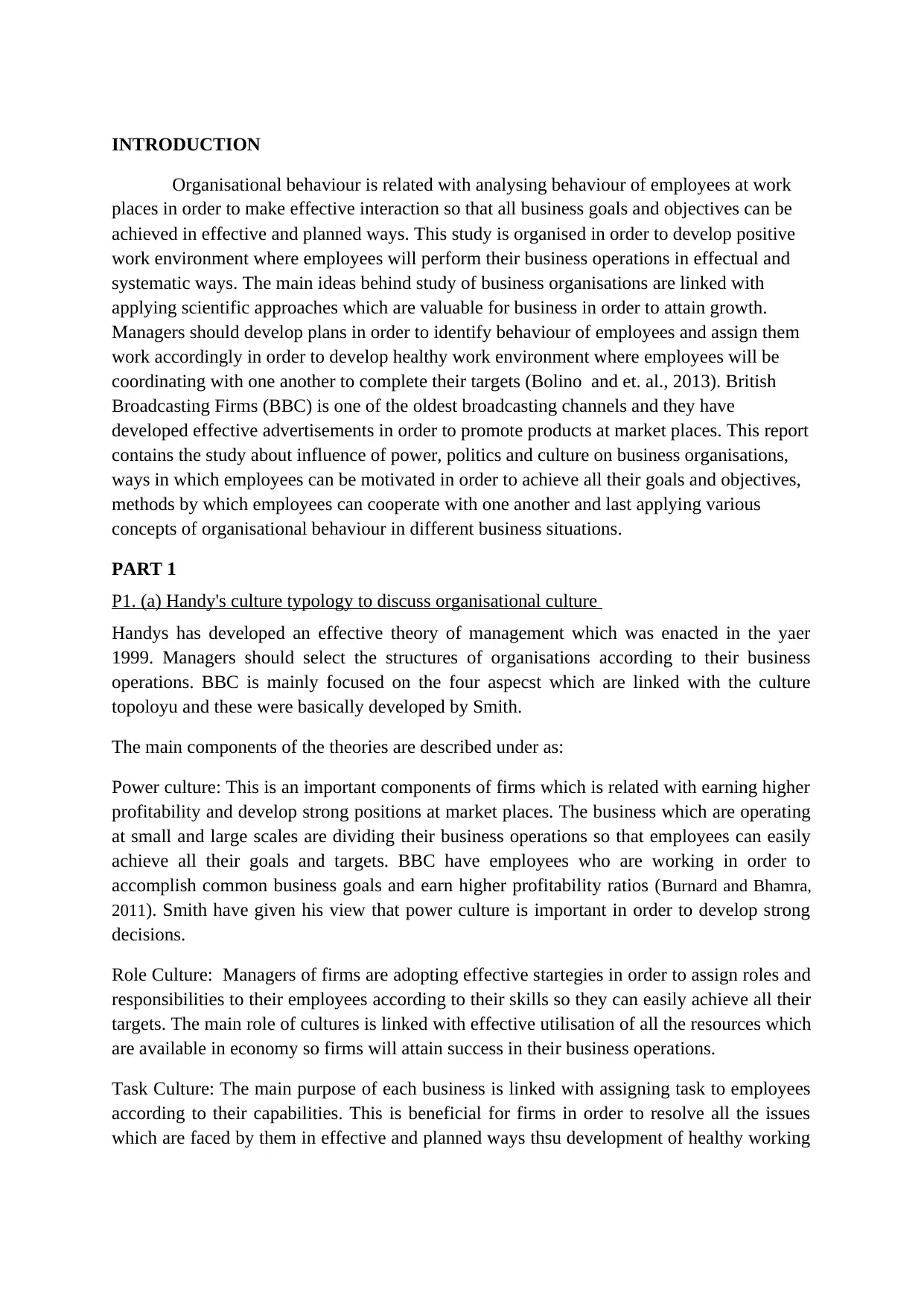
INTRODUCTION
Organisational behaviour is related with analysing behaviour of employees at work
places in order to make effective interaction so that all business goals and objectives can be
achieved in effective and planned ways. This study is organised in order to develop positive
work environment where employees will perform their business operations in effectual and
systematic ways. The main ideas behind study of business organisations are linked with
applying scientific approaches which are valuable for business in order to attain growth.
Managers should develop plans in order to identify behaviour of employees and assign them
work accordingly in order to develop healthy work environment where employees will be
coordinating with one another to complete their targets (Bolino and et. al., 2013). British
Broadcasting Firms (BBC) is one of the oldest broadcasting channels and they have
developed effective advertisements in order to promote products at market places. This report
contains the study about influence of power, politics and culture on business organisations,
ways in which employees can be motivated in order to achieve all their goals and objectives,
methods by which employees can cooperate with one another and last applying various
concepts of organisational behaviour in different business situations.
PART 1
P1. (a) Handy's culture typology to discuss organisational culture
Handys has developed an effective theory of management which was enacted in the yaer
1999. Managers should select the structures of organisations according to their business
operations. BBC is mainly focused on the four aspecst which are linked with the culture
topoloyu and these were basically developed by Smith.
The main components of the theories are described under as:
Power culture: This is an important components of firms which is related with earning higher
profitability and develop strong positions at market places. The business which are operating
at small and large scales are dividing their business operations so that employees can easily
achieve all their goals and targets. BBC have employees who are working in order to
accomplish common business goals and earn higher profitability ratios (Burnard and Bhamra,
2011). Smith have given his view that power culture is important in order to develop strong
decisions.
Role Culture: Managers of firms are adopting effective startegies in order to assign roles and
responsibilities to their employees according to their skills so they can easily achieve all their
targets. The main role of cultures is linked with effective utilisation of all the resources which
are available in economy so firms will attain success in their business operations.
Task Culture: The main purpose of each business is linked with assigning task to employees
according to their capabilities. This is beneficial for firms in order to resolve all the issues
which are faced by them in effective and planned ways thsu development of healthy working
Organisational behaviour is related with analysing behaviour of employees at work
places in order to make effective interaction so that all business goals and objectives can be
achieved in effective and planned ways. This study is organised in order to develop positive
work environment where employees will perform their business operations in effectual and
systematic ways. The main ideas behind study of business organisations are linked with
applying scientific approaches which are valuable for business in order to attain growth.
Managers should develop plans in order to identify behaviour of employees and assign them
work accordingly in order to develop healthy work environment where employees will be
coordinating with one another to complete their targets (Bolino and et. al., 2013). British
Broadcasting Firms (BBC) is one of the oldest broadcasting channels and they have
developed effective advertisements in order to promote products at market places. This report
contains the study about influence of power, politics and culture on business organisations,
ways in which employees can be motivated in order to achieve all their goals and objectives,
methods by which employees can cooperate with one another and last applying various
concepts of organisational behaviour in different business situations.
PART 1
P1. (a) Handy's culture typology to discuss organisational culture
Handys has developed an effective theory of management which was enacted in the yaer
1999. Managers should select the structures of organisations according to their business
operations. BBC is mainly focused on the four aspecst which are linked with the culture
topoloyu and these were basically developed by Smith.
The main components of the theories are described under as:
Power culture: This is an important components of firms which is related with earning higher
profitability and develop strong positions at market places. The business which are operating
at small and large scales are dividing their business operations so that employees can easily
achieve all their goals and targets. BBC have employees who are working in order to
accomplish common business goals and earn higher profitability ratios (Burnard and Bhamra,
2011). Smith have given his view that power culture is important in order to develop strong
decisions.
Role Culture: Managers of firms are adopting effective startegies in order to assign roles and
responsibilities to their employees according to their skills so they can easily achieve all their
targets. The main role of cultures is linked with effective utilisation of all the resources which
are available in economy so firms will attain success in their business operations.
Task Culture: The main purpose of each business is linked with assigning task to employees
according to their capabilities. This is beneficial for firms in order to resolve all the issues
which are faced by them in effective and planned ways thsu development of healthy working
⊘ This is a preview!⊘
Do you want full access?
Subscribe today to unlock all pages.

Trusted by 1+ million students worldwide
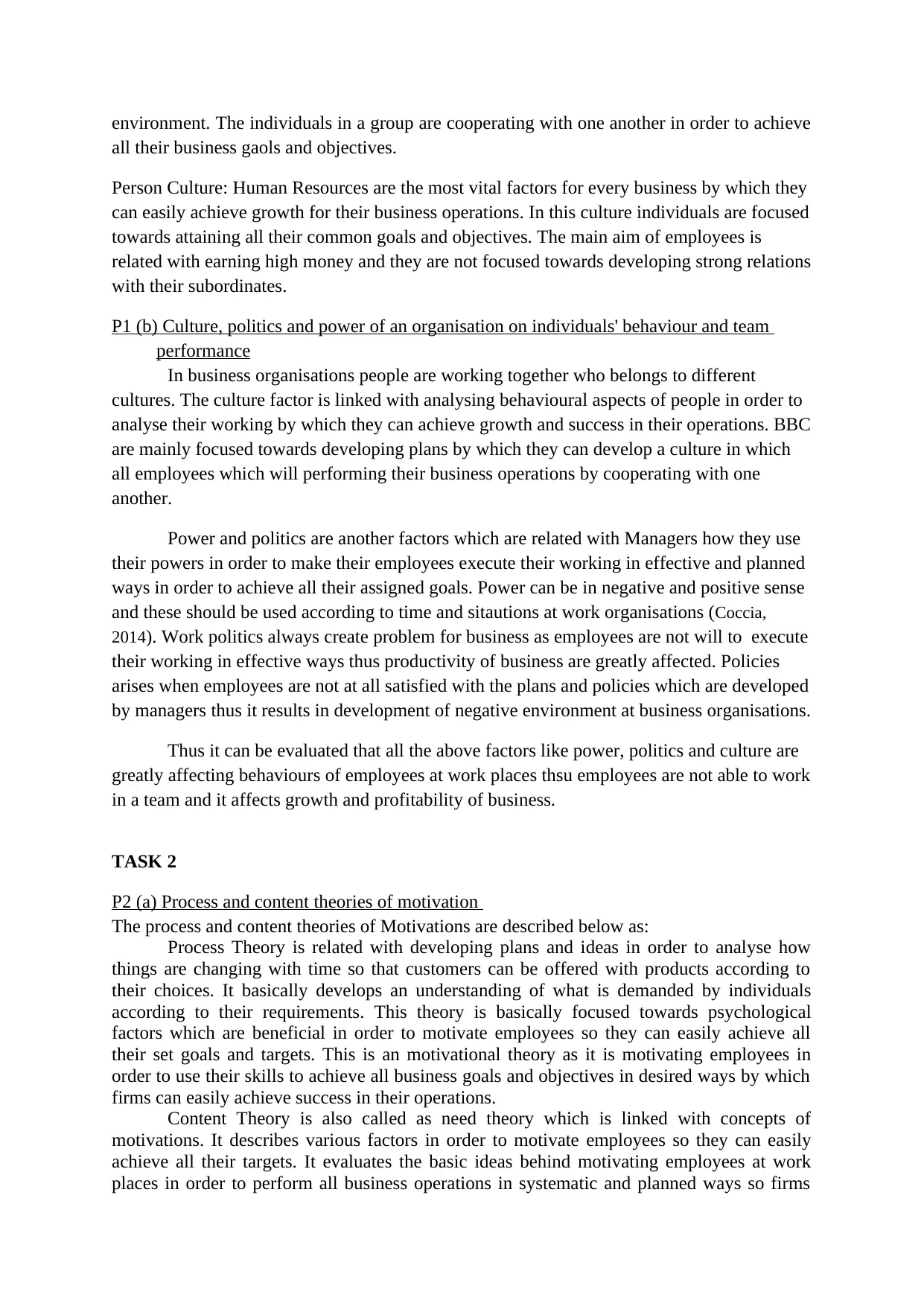
environment. The individuals in a group are cooperating with one another in order to achieve
all their business gaols and objectives.
Person Culture: Human Resources are the most vital factors for every business by which they
can easily achieve growth for their business operations. In this culture individuals are focused
towards attaining all their common goals and objectives. The main aim of employees is
related with earning high money and they are not focused towards developing strong relations
with their subordinates.
P1 (b) Culture, politics and power of an organisation on individuals' behaviour and team
performance
In business organisations people are working together who belongs to different
cultures. The culture factor is linked with analysing behavioural aspects of people in order to
analyse their working by which they can achieve growth and success in their operations. BBC
are mainly focused towards developing plans by which they can develop a culture in which
all employees which will performing their business operations by cooperating with one
another.
Power and politics are another factors which are related with Managers how they use
their powers in order to make their employees execute their working in effective and planned
ways in order to achieve all their assigned goals. Power can be in negative and positive sense
and these should be used according to time and sitautions at work organisations (Coccia,
2014). Work politics always create problem for business as employees are not will to execute
their working in effective ways thus productivity of business are greatly affected. Policies
arises when employees are not at all satisfied with the plans and policies which are developed
by managers thus it results in development of negative environment at business organisations.
Thus it can be evaluated that all the above factors like power, politics and culture are
greatly affecting behaviours of employees at work places thsu employees are not able to work
in a team and it affects growth and profitability of business.
TASK 2
P2 (a) Process and content theories of motivation
The process and content theories of Motivations are described below as:
Process Theory is related with developing plans and ideas in order to analyse how
things are changing with time so that customers can be offered with products according to
their choices. It basically develops an understanding of what is demanded by individuals
according to their requirements. This theory is basically focused towards psychological
factors which are beneficial in order to motivate employees so they can easily achieve all
their set goals and targets. This is an motivational theory as it is motivating employees in
order to use their skills to achieve all business goals and objectives in desired ways by which
firms can easily achieve success in their operations.
Content Theory is also called as need theory which is linked with concepts of
motivations. It describes various factors in order to motivate employees so they can easily
achieve all their targets. It evaluates the basic ideas behind motivating employees at work
places in order to perform all business operations in systematic and planned ways so firms
all their business gaols and objectives.
Person Culture: Human Resources are the most vital factors for every business by which they
can easily achieve growth for their business operations. In this culture individuals are focused
towards attaining all their common goals and objectives. The main aim of employees is
related with earning high money and they are not focused towards developing strong relations
with their subordinates.
P1 (b) Culture, politics and power of an organisation on individuals' behaviour and team
performance
In business organisations people are working together who belongs to different
cultures. The culture factor is linked with analysing behavioural aspects of people in order to
analyse their working by which they can achieve growth and success in their operations. BBC
are mainly focused towards developing plans by which they can develop a culture in which
all employees which will performing their business operations by cooperating with one
another.
Power and politics are another factors which are related with Managers how they use
their powers in order to make their employees execute their working in effective and planned
ways in order to achieve all their assigned goals. Power can be in negative and positive sense
and these should be used according to time and sitautions at work organisations (Coccia,
2014). Work politics always create problem for business as employees are not will to execute
their working in effective ways thus productivity of business are greatly affected. Policies
arises when employees are not at all satisfied with the plans and policies which are developed
by managers thus it results in development of negative environment at business organisations.
Thus it can be evaluated that all the above factors like power, politics and culture are
greatly affecting behaviours of employees at work places thsu employees are not able to work
in a team and it affects growth and profitability of business.
TASK 2
P2 (a) Process and content theories of motivation
The process and content theories of Motivations are described below as:
Process Theory is related with developing plans and ideas in order to analyse how
things are changing with time so that customers can be offered with products according to
their choices. It basically develops an understanding of what is demanded by individuals
according to their requirements. This theory is basically focused towards psychological
factors which are beneficial in order to motivate employees so they can easily achieve all
their set goals and targets. This is an motivational theory as it is motivating employees in
order to use their skills to achieve all business goals and objectives in desired ways by which
firms can easily achieve success in their operations.
Content Theory is also called as need theory which is linked with concepts of
motivations. It describes various factors in order to motivate employees so they can easily
achieve all their targets. It evaluates the basic ideas behind motivating employees at work
places in order to perform all business operations in systematic and planned ways so firms
Paraphrase This Document
Need a fresh take? Get an instant paraphrase of this document with our AI Paraphraser
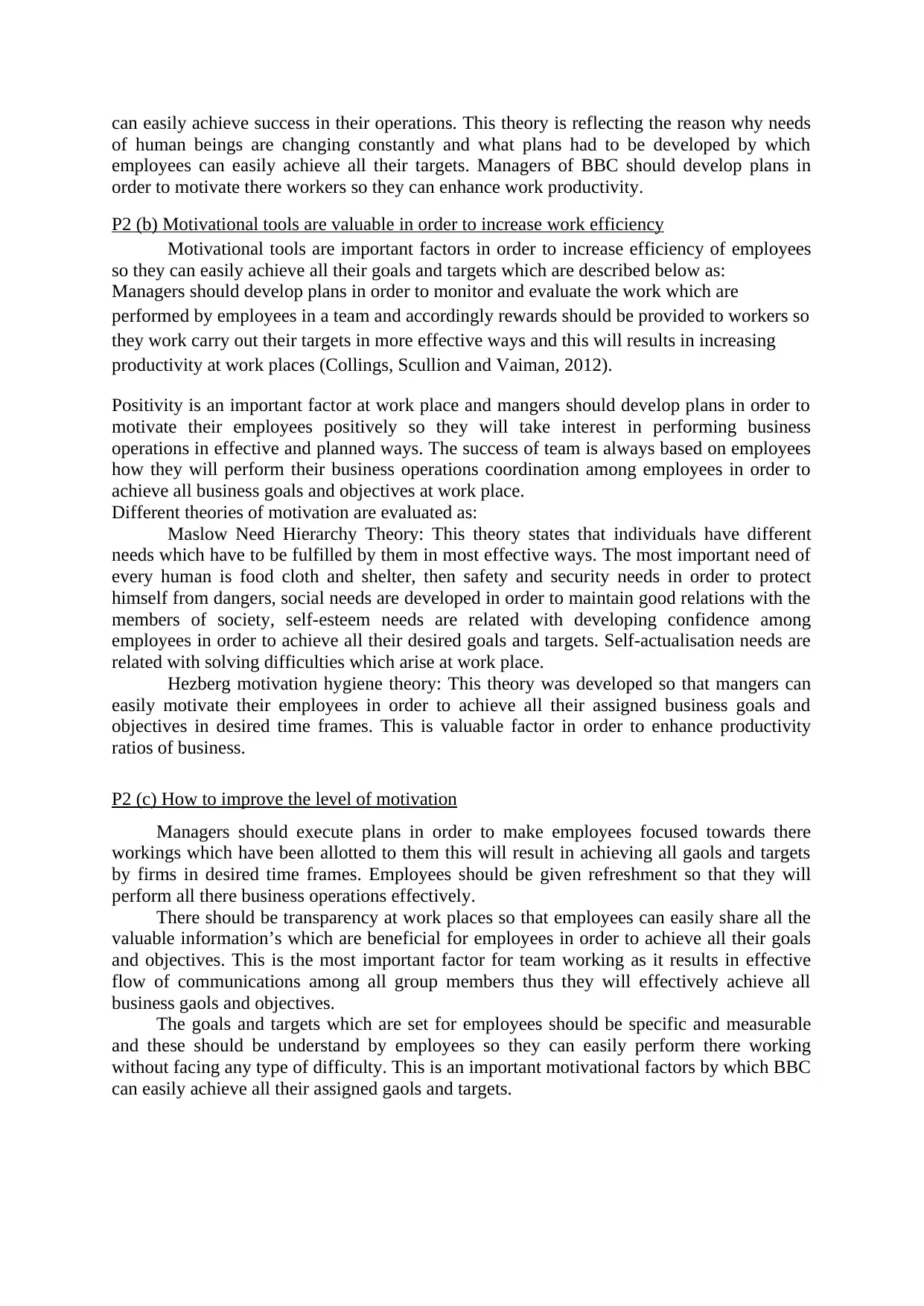
can easily achieve success in their operations. This theory is reflecting the reason why needs
of human beings are changing constantly and what plans had to be developed by which
employees can easily achieve all their targets. Managers of BBC should develop plans in
order to motivate there workers so they can enhance work productivity.
P2 (b) Motivational tools are valuable in order to increase work efficiency
Motivational tools are important factors in order to increase efficiency of employees
so they can easily achieve all their goals and targets which are described below as:
Managers should develop plans in order to monitor and evaluate the work which are
performed by employees in a team and accordingly rewards should be provided to workers so
they work carry out their targets in more effective ways and this will results in increasing
productivity at work places (Collings, Scullion and Vaiman, 2012).
Positivity is an important factor at work place and mangers should develop plans in order to
motivate their employees positively so they will take interest in performing business
operations in effective and planned ways. The success of team is always based on employees
how they will perform their business operations coordination among employees in order to
achieve all business goals and objectives at work place.
Different theories of motivation are evaluated as:
Maslow Need Hierarchy Theory: This theory states that individuals have different
needs which have to be fulfilled by them in most effective ways. The most important need of
every human is food cloth and shelter, then safety and security needs in order to protect
himself from dangers, social needs are developed in order to maintain good relations with the
members of society, self-esteem needs are related with developing confidence among
employees in order to achieve all their desired goals and targets. Self-actualisation needs are
related with solving difficulties which arise at work place.
Hezberg motivation hygiene theory: This theory was developed so that mangers can
easily motivate their employees in order to achieve all their assigned business goals and
objectives in desired time frames. This is valuable factor in order to enhance productivity
ratios of business.
P2 (c) How to improve the level of motivation
Managers should execute plans in order to make employees focused towards there
workings which have been allotted to them this will result in achieving all gaols and targets
by firms in desired time frames. Employees should be given refreshment so that they will
perform all there business operations effectively.
There should be transparency at work places so that employees can easily share all the
valuable information’s which are beneficial for employees in order to achieve all their goals
and objectives. This is the most important factor for team working as it results in effective
flow of communications among all group members thus they will effectively achieve all
business gaols and objectives.
The goals and targets which are set for employees should be specific and measurable
and these should be understand by employees so they can easily perform there working
without facing any type of difficulty. This is an important motivational factors by which BBC
can easily achieve all their assigned gaols and targets.
of human beings are changing constantly and what plans had to be developed by which
employees can easily achieve all their targets. Managers of BBC should develop plans in
order to motivate there workers so they can enhance work productivity.
P2 (b) Motivational tools are valuable in order to increase work efficiency
Motivational tools are important factors in order to increase efficiency of employees
so they can easily achieve all their goals and targets which are described below as:
Managers should develop plans in order to monitor and evaluate the work which are
performed by employees in a team and accordingly rewards should be provided to workers so
they work carry out their targets in more effective ways and this will results in increasing
productivity at work places (Collings, Scullion and Vaiman, 2012).
Positivity is an important factor at work place and mangers should develop plans in order to
motivate their employees positively so they will take interest in performing business
operations in effective and planned ways. The success of team is always based on employees
how they will perform their business operations coordination among employees in order to
achieve all business goals and objectives at work place.
Different theories of motivation are evaluated as:
Maslow Need Hierarchy Theory: This theory states that individuals have different
needs which have to be fulfilled by them in most effective ways. The most important need of
every human is food cloth and shelter, then safety and security needs in order to protect
himself from dangers, social needs are developed in order to maintain good relations with the
members of society, self-esteem needs are related with developing confidence among
employees in order to achieve all their desired goals and targets. Self-actualisation needs are
related with solving difficulties which arise at work place.
Hezberg motivation hygiene theory: This theory was developed so that mangers can
easily motivate their employees in order to achieve all their assigned business goals and
objectives in desired time frames. This is valuable factor in order to enhance productivity
ratios of business.
P2 (c) How to improve the level of motivation
Managers should execute plans in order to make employees focused towards there
workings which have been allotted to them this will result in achieving all gaols and targets
by firms in desired time frames. Employees should be given refreshment so that they will
perform all there business operations effectively.
There should be transparency at work places so that employees can easily share all the
valuable information’s which are beneficial for employees in order to achieve all their goals
and objectives. This is the most important factor for team working as it results in effective
flow of communications among all group members thus they will effectively achieve all
business gaols and objectives.
The goals and targets which are set for employees should be specific and measurable
and these should be understand by employees so they can easily perform there working
without facing any type of difficulty. This is an important motivational factors by which BBC
can easily achieve all their assigned gaols and targets.

TASK 3
P3 (a) Different types of team at work place
There are different types of team which are seen at business organisations are
described below as:
Problem Solving Team: These are teams which are developed for temporary basis and
they are having the main responsibilities in order to resolve all issues which are faced by
employees at work places. These teams’ members are working in order to formulate plans
and policies by which these issues can be easily resolved. The team consist of members from
various departments at work place and they have ski ll and capabilities in order to resolve
those issues. The cross functional system implies that team members are analysing the
problems and then they are making plans in order to resolve them.
Virtual Team: Technology is very essential factors which have helped employees in order to
carry out business operations in various geographical locations. Virtual teams are executing
there business operations through online process in order to make communication more
effective with the help of various conferences, seminars and meeting which are held online.
Due to the development of social networking sites it is possible for virtual team members to
easily communicate with one another about the guidelines of the projects thus team members
can easily perform all there business operations in minimum guidance. All the employees of
the teams should possess skills in order to effectively communicate with one another thus
achieving success (Fuchs and Edwards, 2012).
Cross Functional Teams: In business organisations all the members of the team who
are permanently employed are make connection with all the other departments which are seen
at work place in relation to development of new products at BBC. In this factor the most vital
factor is linked with effective communications between all the department which are
operating internally in order to achieve all gaols and objectives which are related with
projects.
Project team: It is team which is organised by including members from different
teams, who are performing different business operations and they are asked to work on the
same projects. The members of the team execute their working for specified time which has
been allotted to them in order to perform all their business operations. The team members
disperse when they complete their operations and achieve all their goals and targets. These
teams are noticed at work organisations as they are formulated for specific time frame.
P3 (b) How to make an effective team and describe Tuckman model of team development.
Team working is effective for business as it helps in establishing strong coordinations among
all the employees who are involved in business operations thus development of healthy
working environment. BBC are executing there business activities effectively as there are
more then 40,000 employees are working for them in order to achieve all their business goals
and objectives. Each business should develop plans in order to make employees carry out
their operations in effective ways thus attaining success.
Importance of team working are described below as:
Team working helps in equally dividing roles and responsibilities among employees are they
are working in order to achieve their targets.
P3 (a) Different types of team at work place
There are different types of team which are seen at business organisations are
described below as:
Problem Solving Team: These are teams which are developed for temporary basis and
they are having the main responsibilities in order to resolve all issues which are faced by
employees at work places. These teams’ members are working in order to formulate plans
and policies by which these issues can be easily resolved. The team consist of members from
various departments at work place and they have ski ll and capabilities in order to resolve
those issues. The cross functional system implies that team members are analysing the
problems and then they are making plans in order to resolve them.
Virtual Team: Technology is very essential factors which have helped employees in order to
carry out business operations in various geographical locations. Virtual teams are executing
there business operations through online process in order to make communication more
effective with the help of various conferences, seminars and meeting which are held online.
Due to the development of social networking sites it is possible for virtual team members to
easily communicate with one another about the guidelines of the projects thus team members
can easily perform all there business operations in minimum guidance. All the employees of
the teams should possess skills in order to effectively communicate with one another thus
achieving success (Fuchs and Edwards, 2012).
Cross Functional Teams: In business organisations all the members of the team who
are permanently employed are make connection with all the other departments which are seen
at work place in relation to development of new products at BBC. In this factor the most vital
factor is linked with effective communications between all the department which are
operating internally in order to achieve all gaols and objectives which are related with
projects.
Project team: It is team which is organised by including members from different
teams, who are performing different business operations and they are asked to work on the
same projects. The members of the team execute their working for specified time which has
been allotted to them in order to perform all their business operations. The team members
disperse when they complete their operations and achieve all their goals and targets. These
teams are noticed at work organisations as they are formulated for specific time frame.
P3 (b) How to make an effective team and describe Tuckman model of team development.
Team working is effective for business as it helps in establishing strong coordinations among
all the employees who are involved in business operations thus development of healthy
working environment. BBC are executing there business activities effectively as there are
more then 40,000 employees are working for them in order to achieve all their business goals
and objectives. Each business should develop plans in order to make employees carry out
their operations in effective ways thus attaining success.
Importance of team working are described below as:
Team working helps in equally dividing roles and responsibilities among employees are they
are working in order to achieve their targets.
⊘ This is a preview!⊘
Do you want full access?
Subscribe today to unlock all pages.

Trusted by 1+ million students worldwide
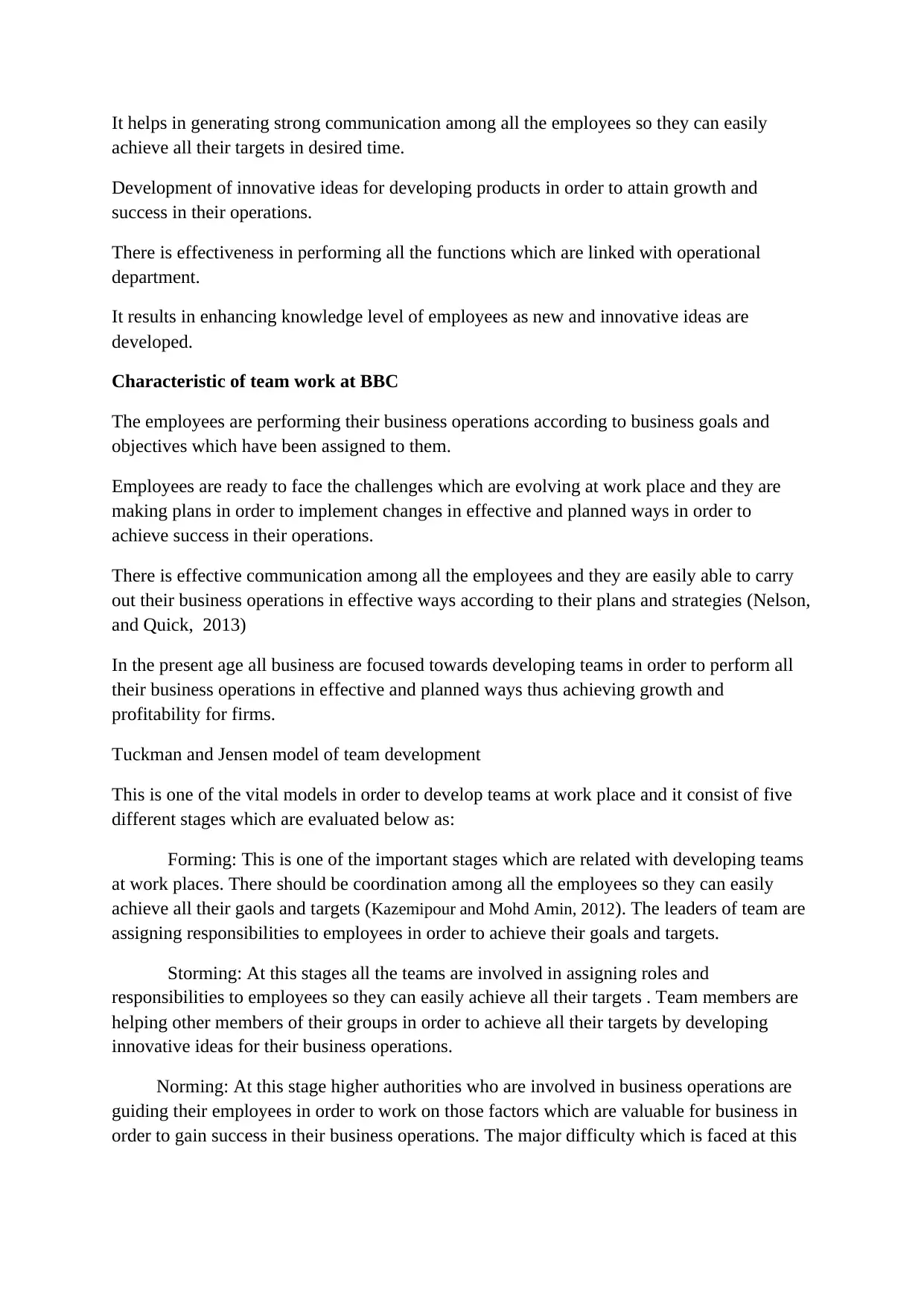
It helps in generating strong communication among all the employees so they can easily
achieve all their targets in desired time.
Development of innovative ideas for developing products in order to attain growth and
success in their operations.
There is effectiveness in performing all the functions which are linked with operational
department.
It results in enhancing knowledge level of employees as new and innovative ideas are
developed.
Characteristic of team work at BBC
The employees are performing their business operations according to business goals and
objectives which have been assigned to them.
Employees are ready to face the challenges which are evolving at work place and they are
making plans in order to implement changes in effective and planned ways in order to
achieve success in their operations.
There is effective communication among all the employees and they are easily able to carry
out their business operations in effective ways according to their plans and strategies (Nelson,
and Quick, 2013)
In the present age all business are focused towards developing teams in order to perform all
their business operations in effective and planned ways thus achieving growth and
profitability for firms.
Tuckman and Jensen model of team development
This is one of the vital models in order to develop teams at work place and it consist of five
different stages which are evaluated below as:
Forming: This is one of the important stages which are related with developing teams
at work places. There should be coordination among all the employees so they can easily
achieve all their gaols and targets (Kazemipour and Mohd Amin, 2012). The leaders of team are
assigning responsibilities to employees in order to achieve their goals and targets.
Storming: At this stages all the teams are involved in assigning roles and
responsibilities to employees so they can easily achieve all their targets . Team members are
helping other members of their groups in order to achieve all their targets by developing
innovative ideas for their business operations.
Norming: At this stage higher authorities who are involved in business operations are
guiding their employees in order to work on those factors which are valuable for business in
order to gain success in their business operations. The major difficulty which is faced at this
achieve all their targets in desired time.
Development of innovative ideas for developing products in order to attain growth and
success in their operations.
There is effectiveness in performing all the functions which are linked with operational
department.
It results in enhancing knowledge level of employees as new and innovative ideas are
developed.
Characteristic of team work at BBC
The employees are performing their business operations according to business goals and
objectives which have been assigned to them.
Employees are ready to face the challenges which are evolving at work place and they are
making plans in order to implement changes in effective and planned ways in order to
achieve success in their operations.
There is effective communication among all the employees and they are easily able to carry
out their business operations in effective ways according to their plans and strategies (Nelson,
and Quick, 2013)
In the present age all business are focused towards developing teams in order to perform all
their business operations in effective and planned ways thus achieving growth and
profitability for firms.
Tuckman and Jensen model of team development
This is one of the vital models in order to develop teams at work place and it consist of five
different stages which are evaluated below as:
Forming: This is one of the important stages which are related with developing teams
at work places. There should be coordination among all the employees so they can easily
achieve all their gaols and targets (Kazemipour and Mohd Amin, 2012). The leaders of team are
assigning responsibilities to employees in order to achieve their goals and targets.
Storming: At this stages all the teams are involved in assigning roles and
responsibilities to employees so they can easily achieve all their targets . Team members are
helping other members of their groups in order to achieve all their targets by developing
innovative ideas for their business operations.
Norming: At this stage higher authorities who are involved in business operations are
guiding their employees in order to work on those factors which are valuable for business in
order to gain success in their business operations. The major difficulty which is faced at this
Paraphrase This Document
Need a fresh take? Get an instant paraphrase of this document with our AI Paraphraser

stage is related with creative work as employees cannot develop new and innovative ideas for
performing business activities.
Performing: At this stages it is the responsibilities of every members who are part of
team in order to develop plans and policies which are beneficial in order to perform all
business activities in effective and planned ways. All the members are having their common
gaols and objectives and they are working on them in order to carry out their business
operations in effective and planned ways.
Adjourning: This is the last stage which is developed when all business goals and
objectives have been analysed and firms have attain success in their operations. Managers
have ideas about the behavioural aspects of employees at work place thus they are motivating
them accordingly in order to achieve their goals and objectives.
TASK 4
P4 (a) Team performance and productivity can be enhanced
Team performance and productivity can be improved at BBC if mangers develop
plans in order to execute path goals theory as it determines the behaviour aspects of
employees and accordingly assign them work thus team productivity can be greatly
enhanced. This is valuable aspects by which firms can easily achieve all their assigned goals
and targets. Goals are important factors as they are helpful in order to motivate all employees
at work place so they can generate productive results by performing all business operations
according to plans.
Path goal theories are always based on Vrooms expectancy theory which states that
people at work organisations are following different expectations according to different
business situations in order to achieve best results thus maximising working productivity. In
this theory leaders are also playing an important role as they are selecting the best and
effective behaviours among all the employees at work place according to needs and demands.
This is valuable factor in order to provide guidance to their employees to walk on the best
paths which are valuable for them in order to gain success in business operations (Kellison and
Mondello, 2011). The main factors of path goal theory is linked with analysing characteristic
and skill of employees then selection of best leadership styles and lastly selection of
motivational tools which are valuable in order to enhance performances of employees at
BBC.
P4 (b) Barriers to effective performances
There are different barriers by which employees are not able to achieve all their
targets in desired time frames thus there performances are greatly affected which are
described below as:
If managers and employees at work place are not able to effectively communicate
with one another then it is the greatest difficulty which is seen at work places (Lumley and et.
al., 2011). It results in affecting productivity as employees will not be able to share the
problems which have been faced by them and this in turn results in development of negative
environment at work place thus business is not able to achieve success by enhancing their
performances.
performing business activities.
Performing: At this stages it is the responsibilities of every members who are part of
team in order to develop plans and policies which are beneficial in order to perform all
business activities in effective and planned ways. All the members are having their common
gaols and objectives and they are working on them in order to carry out their business
operations in effective and planned ways.
Adjourning: This is the last stage which is developed when all business goals and
objectives have been analysed and firms have attain success in their operations. Managers
have ideas about the behavioural aspects of employees at work place thus they are motivating
them accordingly in order to achieve their goals and objectives.
TASK 4
P4 (a) Team performance and productivity can be enhanced
Team performance and productivity can be improved at BBC if mangers develop
plans in order to execute path goals theory as it determines the behaviour aspects of
employees and accordingly assign them work thus team productivity can be greatly
enhanced. This is valuable aspects by which firms can easily achieve all their assigned goals
and targets. Goals are important factors as they are helpful in order to motivate all employees
at work place so they can generate productive results by performing all business operations
according to plans.
Path goal theories are always based on Vrooms expectancy theory which states that
people at work organisations are following different expectations according to different
business situations in order to achieve best results thus maximising working productivity. In
this theory leaders are also playing an important role as they are selecting the best and
effective behaviours among all the employees at work place according to needs and demands.
This is valuable factor in order to provide guidance to their employees to walk on the best
paths which are valuable for them in order to gain success in business operations (Kellison and
Mondello, 2011). The main factors of path goal theory is linked with analysing characteristic
and skill of employees then selection of best leadership styles and lastly selection of
motivational tools which are valuable in order to enhance performances of employees at
BBC.
P4 (b) Barriers to effective performances
There are different barriers by which employees are not able to achieve all their
targets in desired time frames thus there performances are greatly affected which are
described below as:
If managers and employees at work place are not able to effectively communicate
with one another then it is the greatest difficulty which is seen at work places (Lumley and et.
al., 2011). It results in affecting productivity as employees will not be able to share the
problems which have been faced by them and this in turn results in development of negative
environment at work place thus business is not able to achieve success by enhancing their
performances.
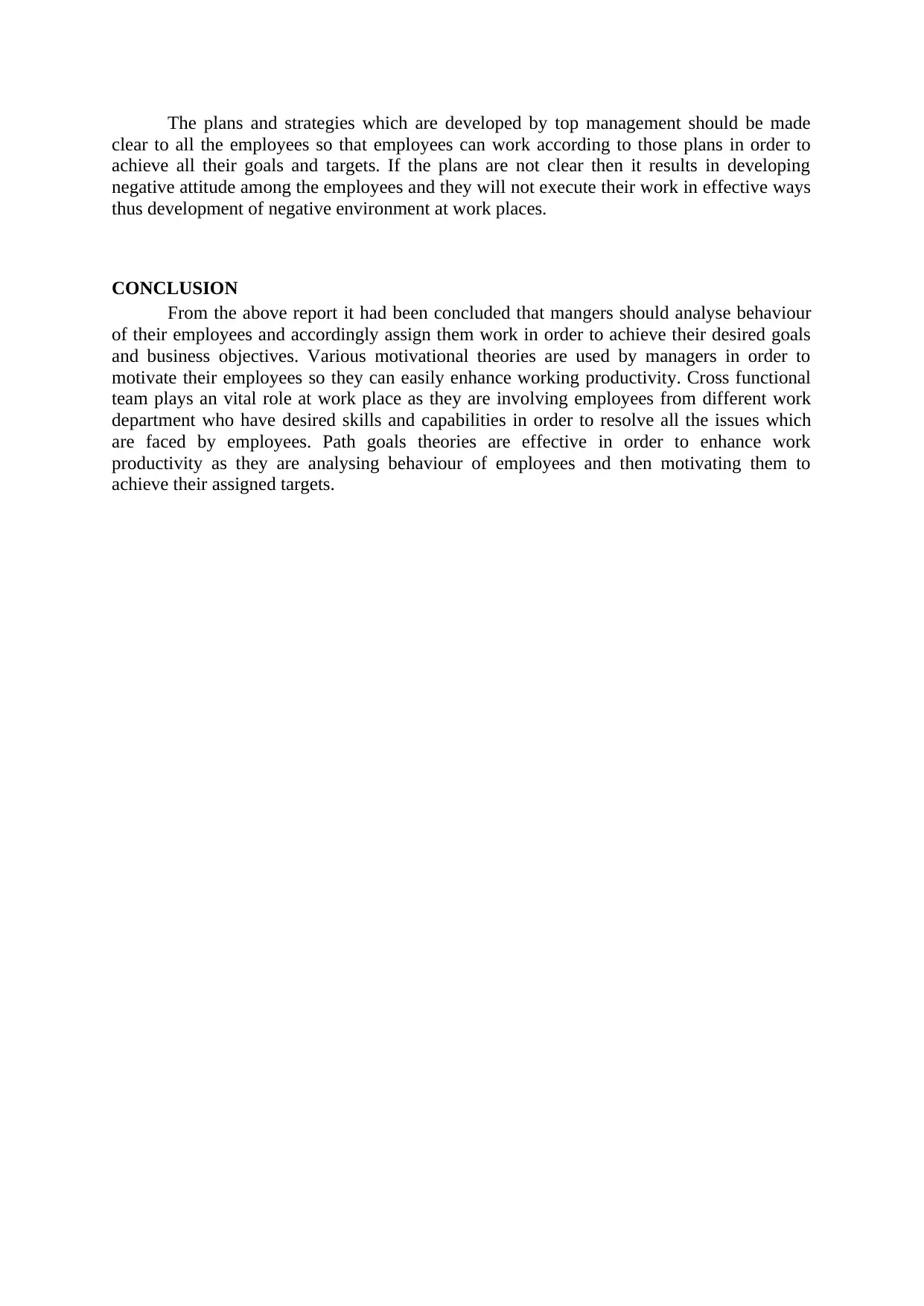
The plans and strategies which are developed by top management should be made
clear to all the employees so that employees can work according to those plans in order to
achieve all their goals and targets. If the plans are not clear then it results in developing
negative attitude among the employees and they will not execute their work in effective ways
thus development of negative environment at work places.
CONCLUSION
From the above report it had been concluded that mangers should analyse behaviour
of their employees and accordingly assign them work in order to achieve their desired goals
and business objectives. Various motivational theories are used by managers in order to
motivate their employees so they can easily enhance working productivity. Cross functional
team plays an vital role at work place as they are involving employees from different work
department who have desired skills and capabilities in order to resolve all the issues which
are faced by employees. Path goals theories are effective in order to enhance work
productivity as they are analysing behaviour of employees and then motivating them to
achieve their assigned targets.
clear to all the employees so that employees can work according to those plans in order to
achieve all their goals and targets. If the plans are not clear then it results in developing
negative attitude among the employees and they will not execute their work in effective ways
thus development of negative environment at work places.
CONCLUSION
From the above report it had been concluded that mangers should analyse behaviour
of their employees and accordingly assign them work in order to achieve their desired goals
and business objectives. Various motivational theories are used by managers in order to
motivate their employees so they can easily enhance working productivity. Cross functional
team plays an vital role at work place as they are involving employees from different work
department who have desired skills and capabilities in order to resolve all the issues which
are faced by employees. Path goals theories are effective in order to enhance work
productivity as they are analysing behaviour of employees and then motivating them to
achieve their assigned targets.
⊘ This is a preview!⊘
Do you want full access?
Subscribe today to unlock all pages.

Trusted by 1+ million students worldwide
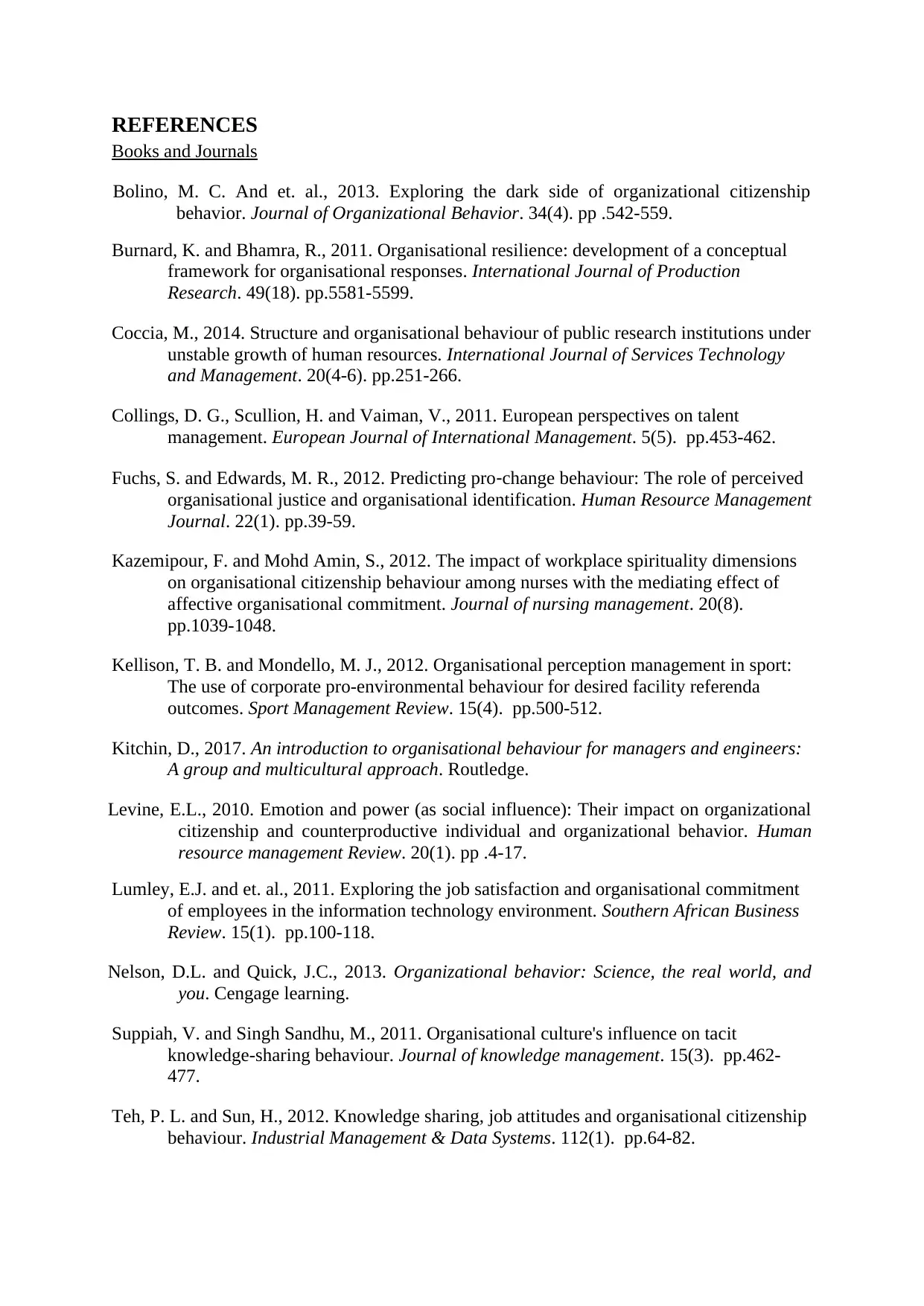
REFERENCES
Books and Journals
Bolino, M. C. And et. al., 2013. Exploring the dark side of organizational citizenship
behavior. Journal of Organizational Behavior. 34(4). pp .542-559.
Burnard, K. and Bhamra, R., 2011. Organisational resilience: development of a conceptual
framework for organisational responses. International Journal of Production
Research. 49(18). pp.5581-5599.
Coccia, M., 2014. Structure and organisational behaviour of public research institutions under
unstable growth of human resources. International Journal of Services Technology
and Management. 20(4-6). pp.251-266.
Collings, D. G., Scullion, H. and Vaiman, V., 2011. European perspectives on talent
management. European Journal of International Management. 5(5). pp.453-462.
Fuchs, S. and Edwards, M. R., 2012. Predicting pro‐change behaviour: The role of perceived
organisational justice and organisational identification. Human Resource Management
Journal. 22(1). pp.39-59.
Kazemipour, F. and Mohd Amin, S., 2012. The impact of workplace spirituality dimensions
on organisational citizenship behaviour among nurses with the mediating effect of
affective organisational commitment. Journal of nursing management. 20(8).
pp.1039-1048.
Kellison, T. B. and Mondello, M. J., 2012. Organisational perception management in sport:
The use of corporate pro-environmental behaviour for desired facility referenda
outcomes. Sport Management Review. 15(4). pp.500-512.
Kitchin, D., 2017. An introduction to organisational behaviour for managers and engineers:
A group and multicultural approach. Routledge.
Levine, E.L., 2010. Emotion and power (as social influence): Their impact on organizational
citizenship and counterproductive individual and organizational behavior. Human
resource management Review. 20(1). pp .4-17.
Lumley, E.J. and et. al., 2011. Exploring the job satisfaction and organisational commitment
of employees in the information technology environment. Southern African Business
Review. 15(1). pp.100-118.
Nelson, D.L. and Quick, J.C., 2013. Organizational behavior: Science, the real world, and
you. Cengage learning.
Suppiah, V. and Singh Sandhu, M., 2011. Organisational culture's influence on tacit
knowledge-sharing behaviour. Journal of knowledge management. 15(3). pp.462-
477.
Teh, P. L. and Sun, H., 2012. Knowledge sharing, job attitudes and organisational citizenship
behaviour. Industrial Management & Data Systems. 112(1). pp.64-82.
Books and Journals
Bolino, M. C. And et. al., 2013. Exploring the dark side of organizational citizenship
behavior. Journal of Organizational Behavior. 34(4). pp .542-559.
Burnard, K. and Bhamra, R., 2011. Organisational resilience: development of a conceptual
framework for organisational responses. International Journal of Production
Research. 49(18). pp.5581-5599.
Coccia, M., 2014. Structure and organisational behaviour of public research institutions under
unstable growth of human resources. International Journal of Services Technology
and Management. 20(4-6). pp.251-266.
Collings, D. G., Scullion, H. and Vaiman, V., 2011. European perspectives on talent
management. European Journal of International Management. 5(5). pp.453-462.
Fuchs, S. and Edwards, M. R., 2012. Predicting pro‐change behaviour: The role of perceived
organisational justice and organisational identification. Human Resource Management
Journal. 22(1). pp.39-59.
Kazemipour, F. and Mohd Amin, S., 2012. The impact of workplace spirituality dimensions
on organisational citizenship behaviour among nurses with the mediating effect of
affective organisational commitment. Journal of nursing management. 20(8).
pp.1039-1048.
Kellison, T. B. and Mondello, M. J., 2012. Organisational perception management in sport:
The use of corporate pro-environmental behaviour for desired facility referenda
outcomes. Sport Management Review. 15(4). pp.500-512.
Kitchin, D., 2017. An introduction to organisational behaviour for managers and engineers:
A group and multicultural approach. Routledge.
Levine, E.L., 2010. Emotion and power (as social influence): Their impact on organizational
citizenship and counterproductive individual and organizational behavior. Human
resource management Review. 20(1). pp .4-17.
Lumley, E.J. and et. al., 2011. Exploring the job satisfaction and organisational commitment
of employees in the information technology environment. Southern African Business
Review. 15(1). pp.100-118.
Nelson, D.L. and Quick, J.C., 2013. Organizational behavior: Science, the real world, and
you. Cengage learning.
Suppiah, V. and Singh Sandhu, M., 2011. Organisational culture's influence on tacit
knowledge-sharing behaviour. Journal of knowledge management. 15(3). pp.462-
477.
Teh, P. L. and Sun, H., 2012. Knowledge sharing, job attitudes and organisational citizenship
behaviour. Industrial Management & Data Systems. 112(1). pp.64-82.
Paraphrase This Document
Need a fresh take? Get an instant paraphrase of this document with our AI Paraphraser
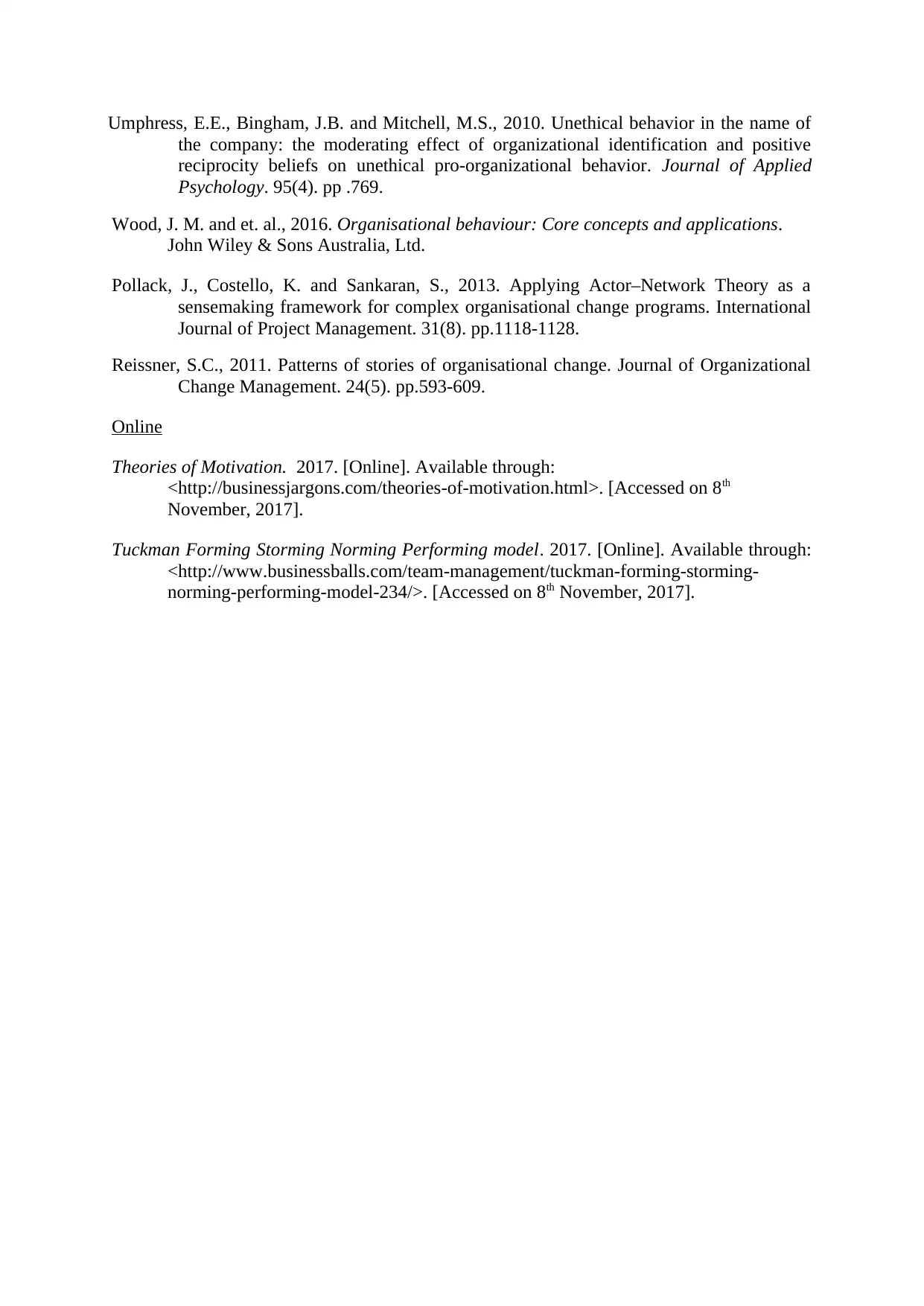
Umphress, E.E., Bingham, J.B. and Mitchell, M.S., 2010. Unethical behavior in the name of
the company: the moderating effect of organizational identification and positive
reciprocity beliefs on unethical pro-organizational behavior. Journal of Applied
Psychology. 95(4). pp .769.
Wood, J. M. and et. al., 2016. Organisational behaviour: Core concepts and applications.
John Wiley & Sons Australia, Ltd.
Pollack, J., Costello, K. and Sankaran, S., 2013. Applying Actor–Network Theory as a
sensemaking framework for complex organisational change programs. International
Journal of Project Management. 31(8). pp.1118-1128.
Reissner, S.C., 2011. Patterns of stories of organisational change. Journal of Organizational
Change Management. 24(5). pp.593-609.
Online
Theories of Motivation. 2017. [Online]. Available through:
<http://businessjargons.com/theories-of-motivation.html>. [Accessed on 8th
November, 2017].
Tuckman Forming Storming Norming Performing model. 2017. [Online]. Available through:
<http://www.businessballs.com/team-management/tuckman-forming-storming-
norming-performing-model-234/>. [Accessed on 8th November, 2017].
the company: the moderating effect of organizational identification and positive
reciprocity beliefs on unethical pro-organizational behavior. Journal of Applied
Psychology. 95(4). pp .769.
Wood, J. M. and et. al., 2016. Organisational behaviour: Core concepts and applications.
John Wiley & Sons Australia, Ltd.
Pollack, J., Costello, K. and Sankaran, S., 2013. Applying Actor–Network Theory as a
sensemaking framework for complex organisational change programs. International
Journal of Project Management. 31(8). pp.1118-1128.
Reissner, S.C., 2011. Patterns of stories of organisational change. Journal of Organizational
Change Management. 24(5). pp.593-609.
Online
Theories of Motivation. 2017. [Online]. Available through:
<http://businessjargons.com/theories-of-motivation.html>. [Accessed on 8th
November, 2017].
Tuckman Forming Storming Norming Performing model. 2017. [Online]. Available through:
<http://www.businessballs.com/team-management/tuckman-forming-storming-
norming-performing-model-234/>. [Accessed on 8th November, 2017].
1 out of 11
Related Documents
Your All-in-One AI-Powered Toolkit for Academic Success.
+13062052269
info@desklib.com
Available 24*7 on WhatsApp / Email
![[object Object]](/_next/static/media/star-bottom.7253800d.svg)
Unlock your academic potential
Copyright © 2020–2025 A2Z Services. All Rights Reserved. Developed and managed by ZUCOL.





